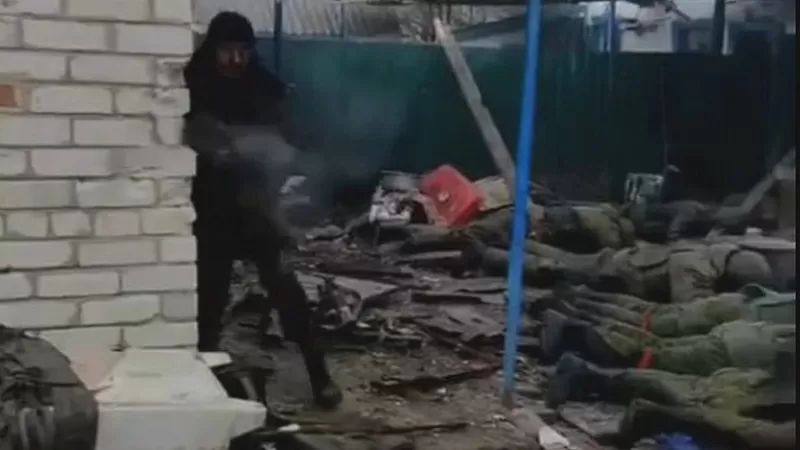Ukraine accuses Russia of #Makiivka perfidy through simulated surrender

Ukraine’s Prosecutor General’s Office has initiated proceedings over the incident in Makiivka (Luhansk oblast) in which at least 12 Russian fighters were killed. While Russia is claiming that these were prisoners of war who had surrendered, examination of video footage has led the Luhansk Regional Prosecutor to classify this as the war crime of perfidy, with the Russians having, allegedly, imitated surrender, only for one of the soldiers to open fire on the approaching Ukrainians.
Russia’s claim that Ukraine had committed the war crime of killing men who had surrendered has been widely reported in the international media. On 21 November, the various allegations were also subjected to scrutiny by the Ukrainian ZMINA Human Rights Centre. The latter pointed out that the video footage available has been verified by satellite images, but that the alleged ‘execution’ had not, thus far, received confirmation.
ZMINA has established the following timeline. The first video footage, seemingly from a drone, was posted on 13 November by a Telegram channel called ‘Operational UAF’. Despite the title, this is not an official Ukrainian Armed Forces account. From the footage, you can seen the bodies of 12 Russian soldiers in Makiivka.
On 18 November, Ukrainian Military TV posted a video in which correspondent Oleksandr Soloviy comes upon the bodies of the Russians whom he calls Wagner Unit mercenaries. ZMINA notes that there had recently been reports on Russian Telegram channels of heavy Russian losses in the village of Makiivka.
By 18 November, Russian officials and Telegram channels were actively circulating the drone footage, as well as one in which Ukrainian military are taking Russians prisoner. This was tweeted by ‘Arthur Morgan’ whose Twitter output appears, at very least, suspiciously single-minded in its (anti-Ukrainian) content.
This video shows Russians in a courtyard being ordered to come out one by one from a building and surrender (by lying on the ground). An armed Ukrainian soldier approaches the building, while other Ukrainian military cover him. After 10 Russians come out, they are asked if all have left. At this point (with everything happening very quickly), another Russian can be seen coming out of the building and, presumably, opening fire.
‘Arthur Morgan’ claimed that the Ukrainians had “recorded themselves executing a large group of Russian s that were taken POW” and posts the drone footage as alleged proof of this. It is nothing of the kind as it all depends on what in fact happened. If, as the Ukrainian Prosecutor now believes, at least one of the men was pretending to surrender in order to then open fire at the Ukrainian soldiers, the latter would be fully entitled to return fire.
Moscow has been swift to provide ‘outraged/ comments about supposed Ukrainian war crimes to the western media, and will doubtless continue to do so. Some western observers are openly unconvinced. Thomas C. Theiner, who identifies himself as formerly in the Italian Army and now a film executive based in Kyiv / Austria dismisses any suggestion that the Russians were executed and is critical of the New York Times journalists who, he said, failed to consult military experts before reporting the allegations. “Instead they went to an Assistant Adjunct Professor for Epidemiology at UC Berkeley, who is quoted: “It looks like most of them were shot in the head,” Dr. Rohini Haar, medical adviser at Physicians for Human Rights, said in an interview. Wrong. And a military expert would have told the NY Times that this is nonsense.” Theiner goes on to show the videos, pointing out that of the five Ukrainians (including the one filming), only the one approaching the building appeared ready to fire, and needed to be as another Russian came out from the building and opened fire. Theiner also rubbishes the assertion that the men were “shot in the head” asking why, then, were there bullet holes in the wall as well? That would surely be more consistent with the shooting that would take place where an apparent surrender proved to be a trick to trap and shoot the Ukrainians.
In its assessment, ZMINA noted that, if this was a simulated surrender, then none of the Russian soldiers enjoyed protection under international law as prisoners of war. Nor is answering fire if you come under attack a war crime (as would be executing POWs in cold blood).
In initiating criminal proceedings under Article 438 of Ukraine’s Criminal Code (war crimes), the Prosecutor cited the 37th Protocol Additional to the Geneva Convention of 12 August 1949. This is entitled Prohibition of perfidy and states that “acts inviting the confidence of an adversary to lead him to believe that he is entitled to, or is obliged to accord, protection under the rules of international law applicable in armed conflict, with intent to betray that confidence, shall constitute perfidy.”





